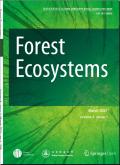A novel method for ULS-TLS forest point cloud registration based on height context descriptor
IF 4.4
1区 农林科学
Q1 FORESTRY
引用次数: 0
Abstract
Unmanned aerial vehicle laser scanning (ULS) and terrestrial laser scanning (TLS) systems are effective ways to capture forest structures from top and side views, respectively. The registration of TLS and ULS data is a prerequisite for a comprehensive forest structure representation. Conventional registration methods based on geometric features (e.g., points, lines, and planes) are likely to fail due to the irregular natural point distributions of forest point clouds. Currently, automatic registration methods for forest point clouds typically rely on tree attributes (such as tree position and stem diameter). However, these methods are often unsuitable for forests with diverse compositions, complex terrains, irregular tree layouts, and insufficient common trees. In this study, an automated method is proposed to register ULS and TLS forest point clouds using ground points as registration primitives, which operates independently of tree attribute extraction and is estimated to reduce processing time by over 50%. A new evaluation method for registration accuracy evaluation is proposed, where transformation parameters from each TLS scan to the ULS obtained by the proposed registration algorithm are used to derive transformation parameters between TLS scans, which are then compared to reference parameters obtained using artificial spherical targets. Conventional ULS-TLS registration evaluation methods mostly rely on the manual corresponding points selection that is subject to inherent subjective errors, or control points in both TLS and ULS data that are difficult to collect. The proposed method presents an objective and accurate solution for ULS-TLS registration accuracy evaluation that effectively eliminates these limitations. The proposed method was tested on 12 plots with diverse stem densities, tree species, and altitudes located in a mountain forest. A total of 124 TLS scans were successfully registered to ULS data. The registration accuracy was assessed using both the conventional evaluation method and the proposed new evaluation method, with average rotation errors of 2.03 and 2.06 mrad, and average translation errors of 7.63 and 6.51 cm, respectively. The registration accuracies demonstrate that the proposed algorithm effectively and accurately registers TLS to ULS point clouds.
基于高度上下文描述符的ULS-TLS森林点云配准新方法
无人机激光扫描(ULS)和地面激光扫描(TLS)系统分别是从顶视图和侧面视图捕获森林结构的有效方法。TLS和ULS数据的注册是全面的森林结构表示的先决条件。传统的基于几何特征(如点、线、面)的配准方法由于森林点云的自然点分布不规则而容易失败。目前,森林点云的自动配准方法通常依赖于树的属性(如树的位置和茎直径)。然而,这些方法往往不适用于成分多样、地形复杂、树木布局不规则、普通树木不足的森林。本文提出了一种以地面点为配准原语的ULS和TLS森林点云自动配准方法,该方法独立于树属性提取,预计可将处理时间减少50%以上。提出了一种新的配准精度评价方法,利用所提配准算法获得的每次TLS扫描到ULS的转换参数,推导出TLS扫描之间的转换参数,并将其与人工球面目标得到的参考参数进行比较。传统的ULS-TLS配准评价方法大多依赖于人工选择对应点,存在固有的主观误差,或者TLS和ULS数据中的控制点难以采集。该方法为ULS-TLS配准精度评价提供了客观准确的解决方案,有效地消除了这些局限性。在某山林12个不同树干密度、树种和海拔的样地上进行了试验。总共有124个TLS扫描成功注册到ULS数据。采用常规评价方法和新评价方法对配准精度进行了评价,平均旋转误差分别为2.03和2.06 mrad,平均平移误差分别为7.63和6.51 cm。配准精度表明,该算法能够有效、准确地将TLS配准到ULS点云。
本文章由计算机程序翻译,如有差异,请以英文原文为准。
求助全文
约1分钟内获得全文
求助全文
来源期刊

Forest Ecosystems
Environmental Science-Nature and Landscape Conservation
CiteScore
7.10
自引率
4.90%
发文量
1115
审稿时长
22 days
期刊介绍:
Forest Ecosystems is an open access, peer-reviewed journal publishing scientific communications from any discipline that can provide interesting contributions about the structure and dynamics of "natural" and "domesticated" forest ecosystems, and their services to people. The journal welcomes innovative science as well as application oriented work that will enhance understanding of woody plant communities. Very specific studies are welcome if they are part of a thematic series that provides some holistic perspective that is of general interest.
 求助内容:
求助内容: 应助结果提醒方式:
应助结果提醒方式:


